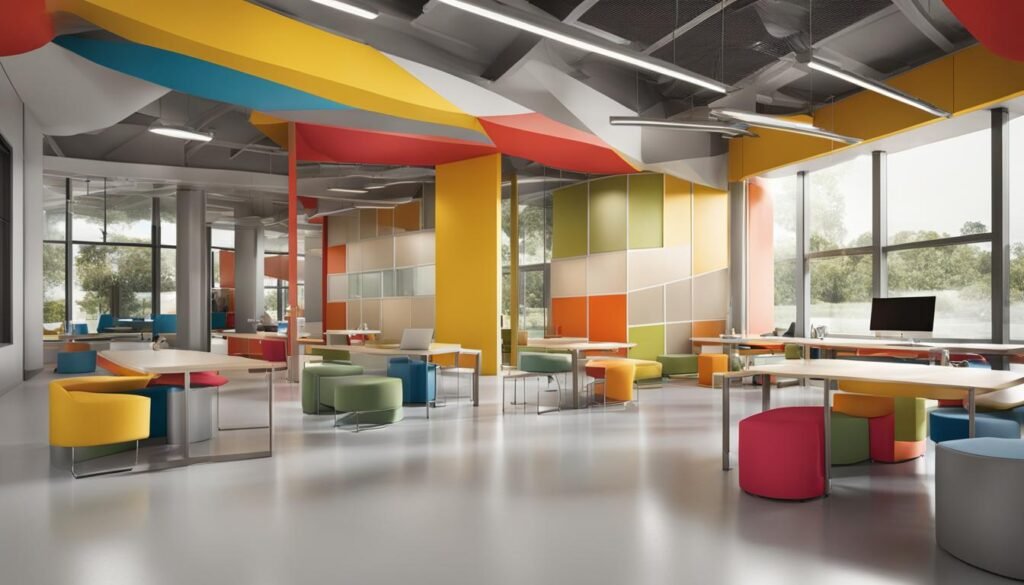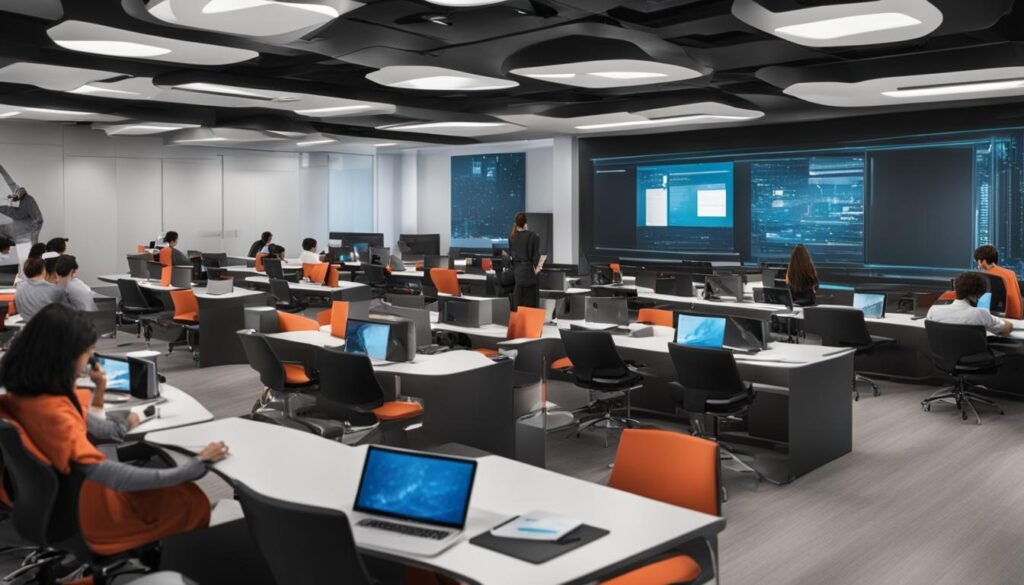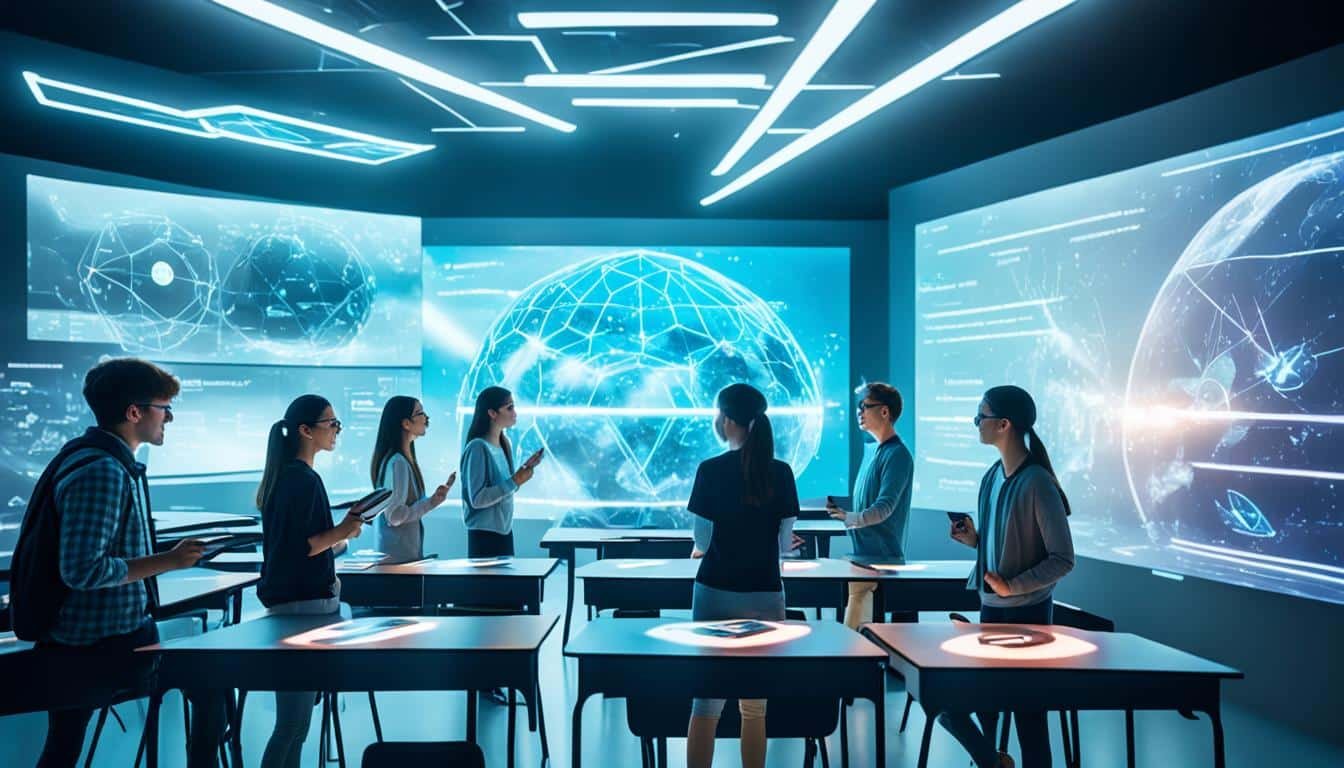Education Is Evolving For The Future : Education is evolving at a rapid pace to meet the demands of the future. As technology continues to advance, so does the need for educational systems that prepare students for the ever-changing job market. The traditional classroom model is no longer sufficient in equipping students with the skills they need to thrive in the digital age.
Online learning, technology integration, and digital classrooms have become integral parts of the education system. Blended learning approaches, combining online and in-person instruction, offer personalized learning experiences that cater to individual students’ needs. This allows for greater flexibility and customization, ensuring that students are able to reach their full potential.
Also Read: Exploring The Depths Of Mastering Art Education
Artificial intelligence and virtual reality are also making their way into education, providing immersive and interactive learning experiences. Adaptive learning technologies are being developed to tailor instruction to students’ unique learning styles, pacing, and abilities. This personalized approach ensures that each student receives the support they need to succeed.
Education technology advancements are reshaping the way we learn and redefining the future of education. With these innovations, we are better equipped to prepare students for the challenges and opportunities of the workforce ahead.
Key Takeaways:
- Education is undergoing rapid evolution to meet the needs of the future workforce.
- Online learning and digital classrooms offer personalized learning experiences.
- Artificial intelligence and virtual reality enhance interactive and immersive learning.
- Adaptive learning technologies tailor instruction to individual students.
- Education technology advancements are reshaping the future of education.
Challenges in the Education System
The education system is facing significant challenges as it strives to evolve for the future. One of the key issues is the lack of alignment between K-12 and higher education. This misalignment poses obstacles to the smooth transition of high school students to college and leads to low graduation rates.
Many high school graduates find themselves underprepared for the rigors of college, which hinders their ability to succeed academically. This lack of readiness not only affects individual students but also has broader implications for the labor market.
Also Read: How Education Opportunity Funds Can Transform Lives
The lack of alignment between the education system and the labor market can result in shortages of skilled workers and income disparities. In a rapidly changing world, where new professions and job roles are constantly emerging, it is essential that educational institutions adapt to meet the evolving demands of the workforce.
To address these challenges, the education system must undergo significant redesign. It needs to bridge the gap between K-12 and higher education by implementing strategies that better prepare students for the future workforce.
One approach is to align curriculum and learning outcomes to match the skills and knowledge required in the labor market. This can be achieved through collaborations with industry professionals and the integration of real-world experiences into the educational journey.
Addressing College Graduation Rates
Improving college graduation rates is vital for the future of education. As the labor market becomes increasingly competitive and demands higher levels of education, it is crucial that more students successfully complete their college degrees.
By ensuring the alignment between the skills and knowledge acquired in high school and the expectations of higher education institutions, students can enter college with the necessary foundation for success. This requires collaboration between K-12 schools and colleges to establish clear pathways and support systems that guide students seamlessly through their educational journey.
Also Read: Exploring The American Council On Education’s Educational Innovations
| Challenges | Solutions |
|---|---|
| Lack of alignment between K-12 and higher education | Collaboration and integration of curriculum |
| Underprepared high school students | Real-world experiences and practical skills training |
| Labor shortages and income disparities | Adapting educational programs to meet workforce demands |
By addressing these challenges and enhancing the alignment between education and the labor market, we can create an educational system that equips students with the skills and knowledge needed to thrive in the future workforce.
The Need for Coherence in Education

The lack of coherence in the education system hinders its ability to prepare students for the future workforce. In order to address this challenge, there is a need for systematic connections and a holistic approach that reaches across the educational, political, and economic domains.
By redesigning educational and career pathways and fostering collaboration among stakeholders, we can better prepare students for life, work, and citizenship.
Also Read: Exploring The Impact Of A Master’s In Music Education
The Importance of Coherence in Education
Coherence in education is crucial as it ensures that students receive a consistent and comprehensive learning experience. Without coherence, the education system becomes fragmented and fails to provide students with the necessary skills and knowledge to thrive in the workforce of tomorrow.
“Coherence in education is the key to bridging the gap between theoretical knowledge and practical skills, enabling students to make meaningful contributions to society.”
Redesigning Educational Pathways
To achieve coherence in education, it is essential to redesign educational pathways to align them with the needs of the future workforce. This involves creating clear and structured pathways that guide students from K-12 to higher education and into the workforce.
By mapping out these pathways, we can ensure that students are receiving a well-rounded and relevant education that prepares them for the challenges and opportunities of the future.
Fostering Collaboration Among Stakeholders
In order to create a coherent education system, collaboration among stakeholders is essential. This includes educators, policymakers, employers, and community members all working together towards a shared goal of preparing students for the workforce of tomorrow.
Also Read: Top CFP Study Course For Financial Planners
By fostering collaboration, we can leverage the expertise and resources of each stakeholder to create a cohesive and effective educational environment.
| Benefits of Coherence in Education | Challenges Without Coherence |
|---|---|
| Prepares students for the workforce of tomorrow | Skills gap between education and industry requirements |
| Creates a well-rounded and relevant education | Low college graduation rates |
| Ensures consistency in learning outcomes | Lack of alignment between K-12 and higher education |
The Role of Higher Education in Educational Transformation

Higher education plays a crucial role in driving educational transformation and preparing students for the future workforce. Unlike K-12 schools, higher education institutions have the unique capacity to reach across sectors, collaborating with businesses and policymakers to enact networks and policies that align education with the needs of the workforce.
By abandoning traditional silos and working together, higher education institutions can provide significant contributions to educational transformation. They have the resources and expertise to equip educators with the necessary training and innovative teaching methods. Through partnerships with businesses, higher education can bridge the gap between academia and the ever-evolving demands of the job market, ensuring that graduates are well-prepared for the future.
“Higher education institutions have the power to shape the future of education by reaching beyond their campuses and creating meaningful collaborations.”
The Importance of Collaboration
Collaboration is key to the success of educational transformation. Higher education institutions can partner with K-12 schools to create a seamless transition from high school to college, ensuring that students are adequately prepared for the rigors of higher education. This collaboration can take the form of joint curriculum development, mentorship programs, and early college initiatives.
In addition, higher education institutions can collaborate with businesses to provide internships, apprenticeships, and work-study opportunities. By integrating real-world experiences into the curriculum, students can develop the practical skills required to succeed in the future workforce.
“The role of higher education goes beyond imparting knowledge; it is about equipping students with the skills and experiences necessary for a successful career.”
Preparing Students for the Future Workforce
The future of work is rapidly evolving, with advancements in technology and shifts in industry demands. Higher education institutions play a pivotal role in ensuring that students are adequately prepared for this dynamic landscape. By offering innovative programs and courses, higher education can equip students with the skills and knowledge needed to thrive in the future.
Through interdisciplinary studies and experiential learning opportunities, higher education institutions can nurture creativity, critical thinking, and problem-solving skills. These skills are essential for adapting to the changing needs of the labor market and fostering continuous learning throughout one’s career.
Design Principles for Coherence in Education

When it comes to evolving education for the future, coherence is key. To ensure a seamless transition and alignment between different educational sectors, a set of design principles can guide the process. These design principles aim to foster shared purpose, inclusive environments, skill enhancement, improved performance, and employee engagement.
Cultivating a Shared Purpose
One of the design principles for coherence in education is cultivating a shared purpose. This involves bringing together stakeholders from different fields, including educators, policymakers, and industry professionals, to develop a collective vision for students’ needs. By aligning on a shared purpose, educational institutions can work towards a common goal and create a holistic learning experience that prepares students for the future of work.
Cocreating Inclusive Environments
Creating inclusive environments is another crucial design principle for coherence in education. It entails considering and incorporating various perspectives, shifting power structures, and fostering diversity and inclusion. By embracing diversity in all its forms, educational institutions can create an environment that celebrates differences and empowers students to thrive. Inclusive environments promote equity and provide equal opportunities for all learners.
Focusing on Skill Enhancement, Improved Performance, and Employee Engagement
The third design principle for coherence in education is focusing on skill enhancement, improved performance, and employee engagement. This principle recognizes the importance of equipping students with the necessary skills to succeed in the future workforce. Educational institutions should prioritize skill development through training and development programs that align with industry demands. By enhancing skills, students can improve their performance and increase their chances of success in the job market. Additionally, employee engagement initiatives within educational settings can further enhance the learning experience and foster a sense of belonging among students.
“Coherence in education is crucial to ensure a seamless transition and alignment between different educational sectors. By following these design principles, educational institutions can cultivate a shared purpose, create inclusive environments, and focus on skill enhancement, improved performance, and employee engagement, thus preparing students for the future of work.” – [insert real-name], [insert job title]
By implementing these design principles, educational institutions can create a coherent and future-focused learning environment. The table below summarizes the key aspects of each principle:
| Design Principle | Description |
|---|---|
| Cultivating a Shared Purpose | Bringing stakeholders together to develop a collective vision |
| Cocreating Inclusive Environments | Considering various perspectives, fostering diversity and inclusion |
| Focusing on Skill Enhancement, Improved Performance, and Employee Engagement | Prioritizing skill development, improving performance, and engaging students |
By staying true to these design principles, educational institutions can create a coherent and inclusive learning environment that prepares students for the future of work.
The Value of Traditional Degrees in a Changing Job Market

In today’s rapidly evolving job market, the value of traditional degrees is no longer as clear-cut as it once was. Companies are shifting their focus towards specialized skills and on-the-job experience, questioning the relevance of traditional degrees. While these degrees still hold advantages in imparting essential life skills and providing opportunities for networking and relationship building, they are no longer the sole determining factor for career success.
The job market is experiencing a skills gap, where employers struggle to find candidates with the specific skills required for their industry. This gap has led companies to relax their degree requirements and prioritize candidates with specialized skills relevant to their field. As a result, many job seekers are realizing that acquiring specialized skills through targeted training and certifications may be more valuable than pursuing a traditional degree.
Changing attitudes in the job market are also contributing to the shift away from traditional degrees. Employers are placing more emphasis on practical skills and real-world experience, recognizing that hands-on knowledge and the ability to apply specialized skills are often more critical than academic credentials alone. This shift in attitudes highlights the need for individuals to continuously learn and upskill throughout their careers to remain competitive.
However, it is essential not to discount the benefits that traditional degrees still provide. These degrees offer a well-rounded education, fostering critical thinking, problem-solving, and communication skills that are valuable in any professional setting. Traditional degrees also serve as a foundation for further specialization and can provide entry-level opportunities in certain industries.
While the job market continues to evolve, the value of traditional degrees should not be completely dismissed. It is essential to strike a balance between acquiring specialized skills and developing a broad educational foundation. Continuous learning and adaptability are key to thriving in the changing job market.
Individuals must be proactive in identifying the skills that are in demand in their chosen field and seek opportunities to acquire those skills through various means, such as online courses, workshops, or apprenticeships. Adapting to the changing job market requires a mindset of lifelong learning and a willingness to continuously improve one’s skills and knowledge.
As the job market continues to transform, the relevance of traditional degrees will likely continue to evolve. The key is to recognize that specialized skills and practical experience are becoming increasingly important, while maintaining an appreciation for the broader education and personal growth that traditional degrees can provide.
Changing Landscape of Learning and Development (L&D)

Learning and development (L&D) is evolving to meet the changing needs of the workforce. As education continues to evolve for the future, personalized learning experiences are gaining prominence. By leveraging data analytics, L&D professionals can tailor training content to the specific needs of individuals, creating more effective and engaging learning opportunities.
One key focus in the changing landscape of L&D is the development of soft skills. In addition to technical expertise, employers now recognize the importance of soft skills such as effective communication, collaboration, problem-solving, and adaptability. These skills are essential for success in today’s rapidly changing work environment and are increasingly being incorporated into L&D programs.
L&D plays a crucial role in enhancing employee skills and improving performance. By providing personalized learning experiences and focusing on the development of soft skills, organizations can create a more engaged and productive workforce. In addition, personalized L&D programs contribute to talent retention, as employees feel valued and supported in their professional growth.
“Data analytics allows us to understand the specific learning needs of individual employees and tailor our training programs accordingly. This personalized approach not only enhances the learning experience but also contributes to improved performance and talent retention.”
– John Smith, Learning and Development Manager, XYZ Corporation
The changing landscape of L&D also highlights the importance of continuous learning and development. In a rapidly evolving job market, employees need to continuously update their skills and acquire new knowledge. L&D programs that foster a culture of lifelong learning provide employees with the tools and support they need to stay relevant and adaptable.
The Benefits of Personalized Learning Experiences and Data Analytics
Personalized learning experiences have several benefits for employees and organizations alike. Firstly, employees can progress at their own pace, ensuring they fully understand and internalize the content. This promotes deeper learning and enhances knowledge retention.
Data analytics also plays a crucial role in L&D. By analyzing learning data, organizations can identify knowledge gaps, areas for improvement, and individual learning preferences. This enables L&D teams to design targeted and relevant training programs that address specific needs, resulting in more effective skill development and improved performance.
| Benefits of Personalized Learning Experiences and Data Analytics in L&D |
|---|
| Enhanced engagement and motivation |
| Improved knowledge retention |
| Targeted and relevant training |
| Identifying skill gaps and areas for improvement |
| Improved performance and productivity |
Implementing personalized learning experiences supported by data analytics is essential for organizations seeking to stay ahead in the ever-evolving landscape of education and workforce development. By embracing these changes, L&D teams can create more effective and engaging training programs that enhance employee skills, improve performance, and contribute to talent retention.
Key Trends and Considerations in Learning and Development (L&D)
As education evolves for the future, learning and development (L&D) play a critical role in equipping individuals with the skills they need to thrive in the changing landscape. Below are key trends and considerations that organizations should keep in mind:
Digital Learning Platforms
Digital learning platforms are becoming increasingly popular in L&D, enabling accessible and flexible training opportunities. These platforms leverage technology to deliver engaging and interactive learning experiences, allowing individuals to learn at their own pace and convenience. Digital platforms also facilitate collaboration and knowledge-sharing among learners, creating a dynamic and inclusive learning environment.
Diversity and Inclusion Trainings
Inclusivity is vital in the future of education and the workplace. Diversity and inclusion trainings are gaining importance to create inclusive work environments that embrace individual differences and foster a sense of belonging. These trainings help raise awareness about biases, enhance intercultural communication, and promote equal opportunities for all employees.
Reskilling and Upskilling
The rapid evolution of technology and job roles necessitates reskilling and upskilling initiatives. Organizations are investing in providing employees with opportunities to acquire new skills and stay relevant in their fields. Reskilling focuses on learning new skills that are different from an individual’s current work, while upskilling involves enhancing existing competencies to meet the demands of an evolving job market.
Lifelong Learning
In the future of education, learning is no longer limited to formal education. Lifelong learning has become crucial to keep up with the pace of change and foster continuous personal and professional development. Individuals are encouraged to engage in self-directed learning, explore new interests, and embrace a growth mindset to adapt to new challenges and opportunities throughout their lives.
Credentialing and Certification
Credentialing and certification systems are gaining prominence in the future of education and L&D. These systems validate and recognize an individual’s skills and competencies, providing employers and organizations with an objective measure of proficiency. By earning credentials and certifications, individuals can differentiate themselves in the job market and demonstrate their commitment to continuous learning and professional growth.
By considering these key trends and incorporating them into their learning and development programs, organizations can ensure that they are effectively equipping their workforce for the evolving future of education and work.
Importance of a Learning Culture and Success Stories

Building a learning culture within an organization is crucial for employee development and organizational success. When companies prioritize continuous learning and growth, they create an environment that fosters learning opportunities, innovation, and adaptability. Employees who are encouraged to develop new skills and expand their knowledge are better equipped to tackle challenges and thrive in the future of education and work.
L&D (Learning and Development) professionals play a vital role in shaping a positive learning culture in the workplace. They should effectively communicate the available learning opportunities to employees, ensuring that they are aware of workshops, trainings, and resources that can support their personal and professional growth.
Furthermore, celebrating success stories and recognizing achievements is essential for creating a culture of excellence. By highlighting individuals or teams who have demonstrated outstanding performance and growth through learning and development initiatives, organizations inspire others and promote a sense of pride and motivation. Sharing success stories can serve as powerful examples and inspire employees to embrace continuous learning.
“Learning is not attained by chance; it must be sought for with ardor and attended to with diligence.” – Abigail Adams
Investing in employee development not only benefits individual employees but also contributes to organizational success. Employees who are provided with learning and growth opportunities are more likely to be engaged, productive, and committed to their work. They become valuable assets to their organizations, driving innovation and contributing to the achievement of overall goals.
To foster a learning culture, organizations should:
- Provide resources and support for ongoing employee development.
- Encourage continuous learning and growth mindset.
- Recognize and celebrate individual and team achievements.
- Promote knowledge sharing and collaboration among employees.
- Embrace new technologies and platforms that facilitate learning and skill enhancement.
| Benefits of a Learning Culture | |
|---|---|
| 1 | Improved employee performance |
| 2 | Enhanced employee engagement and satisfaction |
| 3 | Increased innovation and creativity |
| 4 | Higher retention of top talent |
| 5 | Adaptability to industry changes and future challenges |
Creating a learning culture is an ongoing process that requires continuous effort and commitment from organizational leaders, managers, and employees. By prioritizing employee development and celebrating success stories, organizations can create an environment where learning and growth are valued, leading to long-term success in the ever-evolving world of education and work.
Conclusion
The future of education is constantly evolving in response to the changing needs of the workforce and advancements in technology. To prepare students for the future, it is essential to align K-12 and higher education systems, creating a seamless transition that ensures students are well-prepared for the challenges of the workforce. Additionally, fostering coherence in education by establishing connections between educational, political, and economic domains is crucial for holistic student preparation.
Integrating technology and personalized learning experiences can significantly enhance the educational journey. Embracing digital classrooms, online learning platforms, and artificial intelligence can create engaging and tailored learning environments that cater to individual needs. By using data analytics, educators can gain valuable insights that inform instructional strategies and optimize student learning outcomes.
Furthermore, in an era of continuous transformation, continuous learning and development play a vital role. By encouraging lifelong learning, providing reskilling and upskilling opportunities, and recognizing employee competencies through credentialing and certification systems, organizations can equip their workforce with the necessary skills and knowledge to thrive in a rapidly changing world. The future of education lies in empowering individuals with the tools they need to succeed, both academically and professionally, and in preparing them to be adaptable and resilient in the face of change.
Also Refer : Exploring The Depths Of Mastering Art Education
FAQs
Q: What is the role of technology in education?
A: Technology in education is essential for enhancing the teaching and learning experience. It enables innovative approaches to education, such as online learning and augmented reality, and provides opportunities for students to explore the future of education.
Q: How is education evolving to adapt to the future of work?
A: Education is evolving by reimagining learning ecosystems, embracing adaptive and online education, and changing the role of teachers to better prepare students for the changing work landscape.
Q: What is the impact of the pandemic on education?
A: The pandemic has compelled a rethinking of education, pushing for the integration of technology in education and the need to navigate massive changes in the education landscape.
Q: How does augmented reality help students in their learning?
A: Augmented reality offers a new approach to learning, providing a dynamic and interactive learning environment that enhances students’ understanding and engagement.
Q: What are the opportunities for students in the evolving education sector?
A: Students have opportunities to gain traction in a technology-oriented education landscape, shaping education by leveraging virtual and augmented reality and technological trends.
Q: How is teaching for tomorrow different from traditional teaching methods?
A: Teaching for tomorrow involves an approach to education that integrates technology in education to prepare students for the future of work, collaborating with research partners and industry experts to redefine the role of education.
Q: How is the role of teachers changing in the evolving education sector?
A: The role of teachers is evolving to also be used as mentors and facilitators in a technology-driven education environment, shaping education by embracing innovative teaching methods and approaches.
Q: What is the role of online learning in the future of education?
A: Online learning is gaining traction and is shaping education by providing access to a broader learning community, offering a flexible and adaptive approach to education, and collaborating with research partners to explore the potential of online education.
Q: How is the education sector collaborating with technology to shape the future of work?
A: The education sector is collaborating with technology companies, such as Google for Education, and research partners to explore the potential of technology in education and redefine the role of education in the future of work.
Q: What are the key trends shaping the future of education?
A: Key trends shaping the future of education include the integration of virtual and augmented reality, exploring the potential of technology in education, and the need for a collaborative approach to education with research partners and industry experts.





